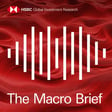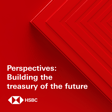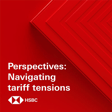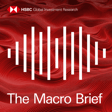Become a Creator today!Start creating today - Share your story with the world!
Start for free
00:00:00
00:00:01

The Macro Viewpoint - COVID-19 in Europe and Australia, US bond yields - HSBC Global Research
In this edition we assess rising COVID-19 cases in Europe, how the Sydney outbreak could stall Australia’s growth prospects and why US bond yields are back to the middle of their range for the year. Disclaimer
To stay connected and to access free to view reports and videos from HSBC Global Research click here
Hosted on Acast. See acast.com/privacy for more information.
Transcript
Introduction to HSBC Global Viewpoint
00:00:00
Speaker
This is HSBC Global Viewpoint, your window into the thinking, trends and issues shaping global banking and markets.
00:00:09
Speaker
Join us as we hear from industry leaders and HSBC experts on the latest insights and opportunities for your business.
00:00:17
Speaker
Thank you for listening.
Macro Viewpoint Podcast Introduction
00:00:24
Speaker
Hello and welcome to the macro viewpoint from HSBC Global Research, our weekly podcast featuring the views of leading HSBC analysts on the outlook for the global economy and markets.
00:00:35
Speaker
I'm Piers Butler and I'm joined by Chris Brown-Humes.
Impact of Rising COVID-19 Cases in Europe
00:00:37
Speaker
Hi Piers, coming up on this week's programme, we look at how the pandemic is evolving.
00:00:42
Speaker
First, we'll take a look at how cases are rising rapidly in some European economies with Simon Wells, Chief European Economist.
00:00:48
Speaker
Then we'll head down under to hear from Paul Bloxham, chief economist for Australia, New Zealand and global commodities, about why an outbreak of the virus in Sydney has led him to downgrade his growth forecast for Australia.
US Bond Yields Analysis with Steve Major
00:01:00
Speaker
And we hear from Steve Major, global head of fixed income research, on why US bond yields have fallen back to the middle of their range for the year.
00:01:07
Speaker
This podcast was recorded on Thursday, the 15th of July, 2021.
COVID-19's Economic Impact in the UK and Spain
00:01:11
Speaker
Our full disclosures and disclaimers can be found in the link attached to this podcast.
00:01:20
Speaker
We begin this week in Europe, where it's a mixed picture on the COVID-19 front.
00:01:24
Speaker
Cases remain low across much of the continent, but there have been sharp spikes in the UK and Spain, despite impressive vaccine rollouts.
00:01:33
Speaker
For more on this and the UK's stronger than expected inflation data, we're joined by Simon Wells, Chief European Economist.
00:01:40
Speaker
So Simon, according to your latest COVID tracker, this Delta variant seems to be on the rise in Europe.
00:01:47
Speaker
What's the outlook there?
00:01:49
Speaker
Well, that's right, Piers.
00:01:50
Speaker
Cases in Europe are very much back on the rise now across most countries, albeit from a very low base in some of them.
00:01:59
Speaker
But incidents of the Delta variant are spreading quite rapidly now.
00:02:04
Speaker
And Spain and the Netherlands have joined Portugal and the UK in seeing really quite rapid rises in cases.
00:02:12
Speaker
Now, so far in terms of the economy, we've not seen any material rowing back in the easing of restrictions.
00:02:21
Speaker
That's a minor reversal in the Netherlands.
00:02:25
Speaker
But it is a growing downside risk and a worry for the future.
00:02:30
Speaker
not least because in the UK, vaccination rates of the elderly in particular are much higher than they are in other parts of Europe and the Eurozone.
00:02:40
Speaker
So for France and Italy, for example, about 60% of 50 to 70 year olds are double vaxxed.
00:02:49
Speaker
Whereas in the UK, you know, that's way north of 80%.
00:02:53
Speaker
So it is a different situation.
UK Inflation and Economic Outlook
00:02:56
Speaker
And it is a concern and growing downside risk for the economic outlook in the eurozone and also, of course, in the UK.
00:03:06
Speaker
Having said that, Simon, the data in the UK recently has actually been quite strong, particularly on the inflation front.
00:03:12
Speaker
Can you comment on that?
00:03:13
Speaker
Yes, that's right.
00:03:14
Speaker
There were several key indicators out of the UK this week, and it won't have done anything to allay fears of anyone worried about inflation.
00:03:22
Speaker
It surprised strongly again to the upside on Wednesday with CPI headline inflation rising to two and a half percent, much stronger than expected.
00:03:32
Speaker
And most of the upside news was in core inflation.
00:03:35
Speaker
Indeed, looking at the monthly rise in core inflation in the UK, it was the strongest for any month of June 2020.
00:03:41
Speaker
since CPI began in 1997.
00:03:44
Speaker
So the UK experience is looking a lot more like what we've seen in the US recently, even if not quite as pronounced.
00:03:53
Speaker
And some of the inflationary pressures we're seeing may prove to be a little more durable.
00:03:58
Speaker
Now on the back of these data on Thursday, we had the labour market.
00:04:02
Speaker
Unemployment rate was steady at 4.8%, but it was pay growth that really grabbed the attention.
00:04:07
Speaker
Total pay rose to 7.3% on the headline three month on year measure.
00:04:12
Speaker
That was up from 5.6% in April.
00:04:15
Speaker
And it means that in real terms, pay is growing at 5.6% as well.
00:04:20
Speaker
Now these are big numbers.
00:04:21
Speaker
Some of it's a composition effect resulting from labour market changes that follow from the pandemic.
00:04:28
Speaker
But even in an underlying sense, these are pretty strong pay numbers.
00:04:33
Speaker
It might not chime with everyone in the UK, but pay is growing strongly in aggregate.
00:04:38
Speaker
Hiring indicators are good.
00:04:40
Speaker
And there are definitely some pockets of tightness in the UK labour market.
00:04:45
Speaker
And in terms of policy implications, you're saying that the Bank of England should nevertheless be patient.
00:04:50
Speaker
What do you mean by that?
00:04:51
Speaker
Well, I think, first of all, I should say we have revised up our near term inflation forecast as a result of this news.
00:04:59
Speaker
And over the coming months, our inflation forecast is averaging half a percentage point higher than we previously expected.
00:05:07
Speaker
So inflation in the UK could reach 3% in August, we think.
00:05:12
Speaker
And this hasn't escaped the MPC's notice.
00:05:15
Speaker
We've had several comments this week from MPC members.
00:05:18
Speaker
Dave Ramson on Wednesday saying that tightening could come sooner than previously thought.
00:05:22
Speaker
These sentiments were echoed by Michael Saunders on Thursday when he said it might be appropriate to withdraw some policy stimulus fairly soon.
00:05:31
Speaker
So clearly some members of the MPC are getting a bit hawkish.
00:05:36
Speaker
That said, it is our view that they're going to want to wait and see in the data that the job support measures have been rolled off in a fairly orderly fashion.
00:05:45
Speaker
They may want to wait and see what happens with some of these COVID downside risks.
00:05:50
Speaker
And so the governor has said that a lot of this may be temporary and the bank can afford to be patient.
00:05:58
Speaker
That said, I think when we get into next year, they see all these data.
00:06:02
Speaker
Some modest tightening probably is warranted.
00:06:04
Speaker
And a reminder of our view is that the Bank of England will raise rates by 15 basis points next May.
00:06:11
Speaker
Follow that up with a 25 basis point rise next November and then at least one rate rise in 2023.
00:06:18
Speaker
Although, of course, there are risks to this view in both directions.
00:06:22
Speaker
Very clear, Simon.
00:06:23
Speaker
Thank you very much.
00:06:24
Speaker
Thank you.
Australia's Growth Forecast amid Sydney Lockdown
00:06:28
Speaker
The UK is opening up on July the 19th, despite rising cases.
00:06:32
Speaker
On the other side of the world, it's a different story.
00:06:34
Speaker
In Australia, an outbreak of the Delta variant has put Greater Sydney back into lockdown.
00:06:39
Speaker
This has led Paul Bloxham, our chief economist for Australia, to cut his growth forecasts.
00:06:44
Speaker
He joins us from Sydney.
00:06:46
Speaker
So, Paul, Australia and New Zealand have been pretty successful in containing this virus until now.
00:06:51
Speaker
So how much of a blow is this outbreak in Sydney?
00:06:54
Speaker
Oh, it's certainly a significant risk.
00:06:56
Speaker
As you say, Australia and New Zealand actually have had this great benefit of being distant islands.
00:07:02
Speaker
And the strategy they've run so far has been shut the borders, keep the virus out.
00:07:07
Speaker
If it gets in in any places, quick, sharp lockdowns or using the testing, tracing and quarantining to contain it.
00:07:13
Speaker
And they've managed to keep it essentially out of the community.
00:07:15
Speaker
I mean, New Zealand still has.
00:07:16
Speaker
But Australia, well, we've got this outbreak now in Sydney in particular, the Delta outbreak.
00:07:21
Speaker
And we think there's a risk here that this is actually a turning point for the whole national strategy because in large part because Delta moves so much faster that it's quite hard for the testing, tracing and quarantining to keep up.
00:07:33
Speaker
And if that's the case, we will become much more reliant, of course, on the vaccinations being the way that we deal with managing the virus.
00:07:40
Speaker
And unfortunately, Australia is still lagging there.
00:07:42
Speaker
I mean, the vaccination rate nationally for double jabs is only 10%.
00:07:47
Speaker
It's catching up, but it's still quite low.
00:07:49
Speaker
So that means we're in a lockdown in Sydney right now.
00:07:52
Speaker
In fact, they've just announced a lockdown, a short lockdown in Victoria as well.
00:07:56
Speaker
And they're trying to contain it that way.
00:07:58
Speaker
And that's going to weigh on economic activity in the second half of this year.
00:08:02
Speaker
So let me just pick you up on that last point.
00:08:04
Speaker
How do you expect the economy to be affected by this?
00:08:06
Speaker
Well, we've seen a really strong bounce back in GDP.
00:08:10
Speaker
The second half of last year and the first quarter of this year, we got all the way back above the pre-pandemic level by Q1 and for employment as well.
00:08:17
Speaker
However, obviously, we think growth is going to slow from here.
00:08:21
Speaker
We've had that in mind for a while anyway, because the border is closed and that's stalling population growth.
00:08:26
Speaker
The other factor we have had in mind is that the fiscal impulse is going to fade.
00:08:30
Speaker
And that will weigh on growth.
00:08:31
Speaker
But now, of course, we've also got the Greater Sydney lockdown.
00:08:35
Speaker
And we think that that's going to see that GDP does actually contract in the third quarter of this year and installs overall in the second half of this year.
00:08:43
Speaker
As a result of that, revised down our growth forecast for 21 from 5.1% to 4.5%.
00:08:49
Speaker
But probably more interestingly and importantly, for 22, we've revised our growth numbers down from 2.8% to 2.4%.
Australia's Fiscal Response to COVID-19
00:08:56
Speaker
So we do have a decent slowdown in the Australian growth story factored in now.
00:09:00
Speaker
So, Paul, how are policymakers responding?
00:09:03
Speaker
So they've stepped up with decent fiscal support.
00:09:06
Speaker
We've seen it at both the state level from New South Wales government and also the federal level in terms of particularly supporting the jobs market in the face of the lockdowns that have been delivered.
00:09:15
Speaker
But these fiscal measures are not nearly as large as we saw earlier.
00:09:20
Speaker
in last year's lockdowns and in the initial missile phase of the COVID shock.
00:09:25
Speaker
So we still think that the fiscal impulse is going to be fading overall.
00:09:29
Speaker
It's not going to be as big a support now as it was earlier on, despite these measures that have been announced.
00:09:34
Speaker
And we think the RBA is going to remain dovish.
00:09:36
Speaker
They've remained dovish all through this, and we think they're going to remain in that stance.
00:09:41
Speaker
That's an excellent summary.
00:09:42
Speaker
Paul, great talking to you today.
00:09:43
Speaker
Thanks very much.
00:09:44
Speaker
Thank you.
US Treasury Yields and Economic Indicators
00:09:48
Speaker
Nine big themes form a key part of our thinking here at Global Research, and in the fixed income market, we've long held the view that bond yields will stay lower for longer.
00:09:56
Speaker
This week, Steve Major, Global Head of Fixed Income Research, looked at why US Treasury yields have fallen back to the middle of their range for the year, having moved higher in the first quarter.
00:10:05
Speaker
Let's hear from him now.
00:10:07
Speaker
Now, during the first quarter, we can see those yields going up through what was known now as the reflation trade.
00:10:14
Speaker
And there was huge enthusiasm back then as many forecasters were doubling their GDP forecasts and projecting Treasury yields above 2% by the end of this year.
00:10:27
Speaker
What we've seen is the yields peaking out above the 170 level and since coming back right into the middle of the range.
00:10:35
Speaker
Now, I think some people are trying to explain this away with short covering, position squaring, et cetera, but that's a technical explanation.
00:10:44
Speaker
To me, there's something much more fundamental, and I'm gonna focus on four key drivers of what's taken the bond yield back into the middle of the range.
00:10:54
Speaker
So first of all, the peak optimism has passed and sentiment indicators seem to have gone past the top level.
00:11:03
Speaker
And as I said, it's a first quarter phenomenon when there was the peak optimism.
00:11:10
Speaker
Secondly, debt levels.
00:11:12
Speaker
We've always focused on this as a key driver for the longer run valuation on bonds.
00:11:18
Speaker
More debt is associated with lower yields.
00:11:22
Speaker
And there's nothing like the chance of a rate hike that brings all this into focus for both DM and EM.
00:11:30
Speaker
The third point is inflation.
00:11:33
Speaker
Now, as part of the reflation narrative, I think that inflation expectations were fully embedded in those bond yields.
00:11:43
Speaker
at the start of the year.
00:11:44
Speaker
And we saw 2.5% on five-year break-evens.
00:11:48
Speaker
That's pretty in line with what the Fed was hoping to see with its average inflation target.
00:11:55
Speaker
And this brings me to the last point, the fourth point.
00:11:58
Speaker
If rates were to go up, as some on the FOMC who are projecting that, we saw it in the June FOMC, it seems likely, especially given the big debt stocks out there in the global economy, that when rates do go up, they won't go to the level of the previous cycle.
00:12:17
Speaker
The Fed's been projecting the longer run rate at 2.5%.
00:12:21
Speaker
But the simple point is, the market was already trading with yields above that earlier this year.
00:12:29
Speaker
That's why we're stuck in the middle.
Podcast Conclusion and Listener Invitation
00:12:32
Speaker
That brings us to the end of today's macro viewpoint.
00:12:34
Speaker
Thank you to our guests, Simon Wells, Paul Bloxham, and Steve Major.
00:12:38
Speaker
From Pearson Mead, thanks very much for listening.
00:12:40
Speaker
We'll be back again next week.
00:12:50
Speaker
Thank you for listening today.
00:12:51
Speaker
This has been HSBC Global Viewpoint, Banking and Markets.
00:12:56
Speaker
For more information about anything you heard in this podcast or to learn about HSBC's global services and offerings, please visit gbm.hsbc.com.

















